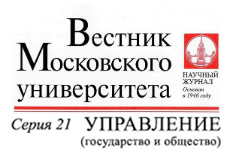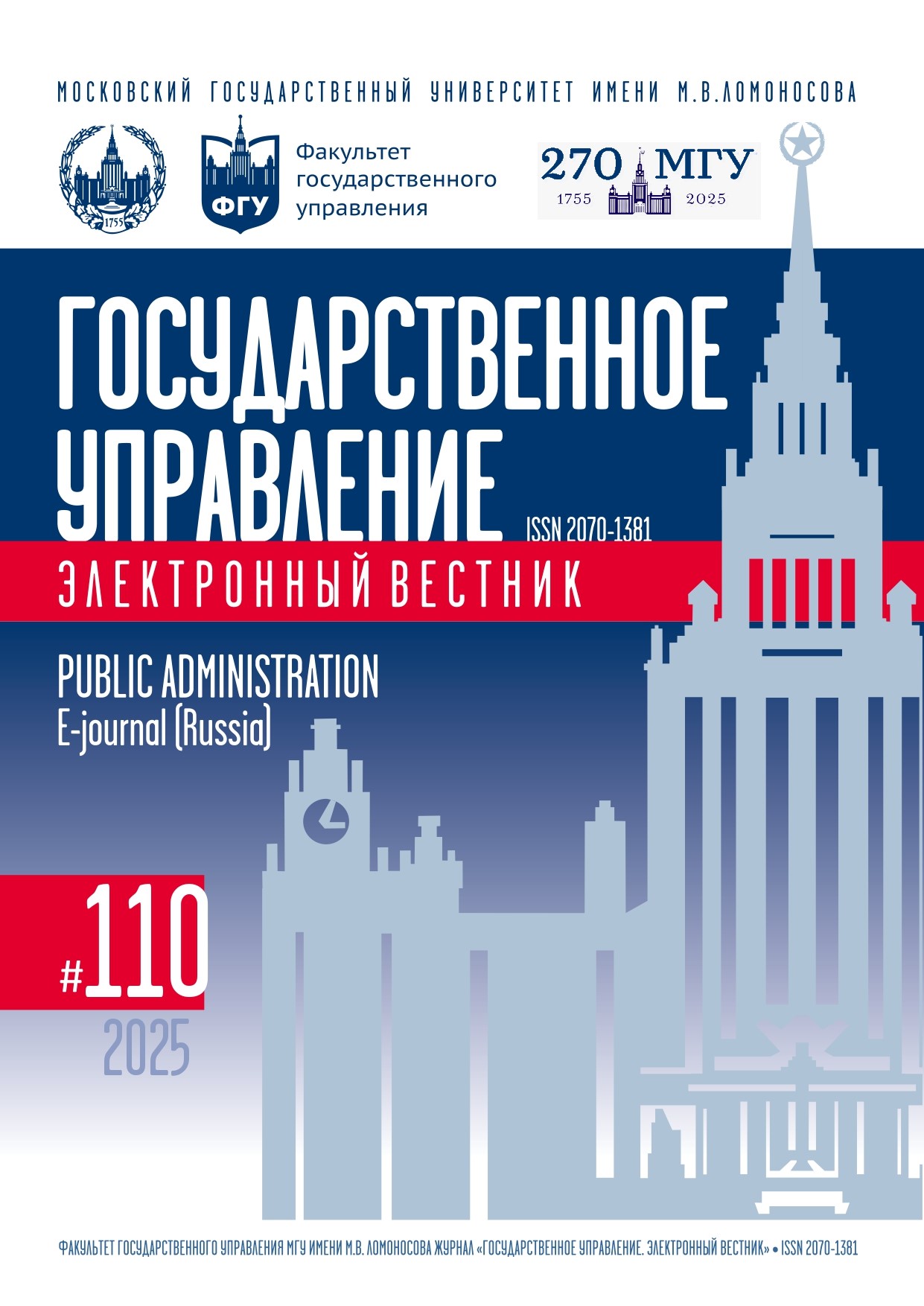Was There Anything to Cure with? The Anti-Inflation Aspect of Shock Therapy through the Lens of the State Capacity Concept (1991–1992)
DOI:
https://doi.org/10.55959/MSU2070-1381-110-2025-87-100Keywords:
State capacity, shock therapy, privatization, monopolies, tax system, finance, bureaucracy, state apparatus, Gaidar, Yeltsin.Abstract
The study is devoted to assessing the potential of government agencies in implementing the anti-inflation policy of the Yeltsin-Gaidar government. The need for a consistent analysis of the public administration system elements involved in the implementation of this policy determined the use of retrospective and structural-functional methods. The theoretical foundation of the research is the concept of state capacity, which focuses on establishing the relationship between the parameters of the state apparatus and its ability to achieve the set goals. An integral component of this concept, bureaucratic capacity, was employed to study the condition of government agencies from a personnel and organizational perspective. The subject of the study was a part of the public administration system, whose functionality determined the prospects for implementing the anti-inflation policy. The list of specific government bodies was identified based on four main directions: antitrust, foreign trade, tax, and fiscal-budgetary policy. The corresponding services, state committees, and organizations were examined in three aspects: personnel and organizational capacity, regulatory framework, and resource availability. The results of the study showed that government agencies were unprepared to operate under market reform conditions. They suffered from an acute lack of expertise, operated within an underdeveloped infrastructural and institutional environment, and faced significant funding shortages. The ideological principles and socio-economic realities of 1992 created long-term conditions for the degradation of bureaucratic capacity. The decline in the state’s ability to concentrate resources, enforce policies, and manage administrative processes rendered the anti-inflation objectives of shock therapy unattainable within the planned timeframe. Unrealistic goal-setting led to negative consequences such as additional socio-economic costs, destructive forms of social adaptation, and increased political tensions. The findings of the study revealed the need to align state capacity with the desired outcomes of government policies through a preliminary audit of relevant elements of the bureaucratic apparatus.
References
Волынский А.И. Институциональный дизайн и теория реформ в российском экономическом дискурсе // Terra Economicus. 2018. Т. 16. № 4. С. 29–40. DOI: 10.23683/2073-6606-2018-16-4-29-40
Купряшин Г.Л. Политико-административные способности государственного управления в условиях турбулентности и неопределенности // Государственное управление. Электронный вестник. 2023. № 97. С. 174–189. DOI: 10.24412/2070-1381-2023-97-174-189
Логвенков И.С. Взаимоотношения центральных и региональных органов исполнительной власти в контексте подготовки радикальных рыночных преобразований в России в конце 1991 г. // Исторический журнал: научные исследования. 2024. № 5. С. 174–185. DOI: 10.7256/2454-0609.2024.5.71927
Besley J.T., Burgess R., Khan A., Xu G. Bureaucracy and Development // Annual Review of Economics. 2022. Vol. 14. P. 397–424. DOI: 10.1146/annurev-economics-080521-011950
Cingolani L. The State of State Capacity: A Review of Concepts, Evidence and Measures // MERIT Working Papers. 2013. No. 053. URL: https://unu-merit.nl/publications/wppdf/2013/wp2013-053.pdf
Cornel A., Knutsen H.C., Teorell J. Bureaucracy and Growth // Comparative Political Studies. 2020. Vol. 53. Is. 14. P. 2246–2282. DOI: 10.1177/0010414020912
Dincecco M., Wang Y. State Capacity in Historical Political Economy // The Oxford Handbook of Historical Political Economy / ed. by A.J. Jenkins, J. Rubin. 2022. P. 253–270. DOI: 10.1093/oxfordhb/9780197618608.013.13
Hanson J., Sigman R. Leviathan’s Latent Dimensions: Measuring State Capacity for Comparative Political Research // The Journal of Politics. 2021. Vol. 83. No. 4. P. 1495–1510. DOI: 10.1086/715066
Khemani S. What is State Capacity? // Policy Research Working Paper No. 8734. 2019. URL: https://openknowledge.worldbank.org/server/api/core/bitstreams/1a4179ef-c2c9-54ae-8b2a-05e77e0745b5/content
Lindsey B. State Capacity. What Is It, How We Lost It, And How to Get It Back // Niskanen Center Studies. 2021. URL: https://www.niskanencenter.org/wp-content/uploads/2021/11/brinkpaper.pdf
Soifer H., Hau M. Unpacking the Strength of the State: The Utility of State Infrastructural Power // Studies in Comparative International Development. 2008. Vol. 43. P. 219–230. DOI: 10.1007/s12116-008-9030-z
Downloads
Published
Similar Articles
- Igor N. Molchanov, Natalia P. Molchanova, State Financial Policy of Russia: Features of Development and Implementation in New Geopolitical Conditions , Public Administration. E-journal (Russia): No. 100 (2023)
- Timur O. Tarba, Instruments of Interaction between State Corporations and Subjects of the Russian Federation , Public Administration. E-journal (Russia): No. 109 (2025)
- Aleksandra A. Sidorova, University-Business Cooperation Support System in the Context of Global Instability , Public Administration. E-journal (Russia): No. 86 (2021)
- Lyubov V. Ulyanova, The System of Social Sciences in the Context of Civilizational Approach: Formulating the Problem , Public Administration. E-journal (Russia): No. 104(S) (2024): The Concept of Russian Civilization: New Trends in Scientific Discussions
- Ekaterina I. Shumskaya, Reproduction of Human Potential in Economic Development Strategies from a Cross-Country Perspective , Public Administration. E-journal (Russia): No. 111 (2025)
- Igor N. Molchanov, Natalia P. Molchanova, Planning in Russia: Origins and Perspectives , Public Administration. E-journal (Russia): No. 90 (2022)
- Ilya N. Lenkov, Vladimir S. Osipov, Transformation of International Financial System: The Role of BRICS Bridge Platform , Public Administration. E-journal (Russia): No. 107 (2024)
- Andrei A. Salnikov, The Government Reform of 1993–1994 in Russian Federation: Background, Course and Results , Public Administration. E-journal (Russia): No. 91 (2022)
- Nina A. Voskolovich, Modern Hotel Industry Formation as the Basis of Tourism Industry , Public Administration. E-journal (Russia): No. 85 (2021)
- Igor N. Molchanov, Natalia P. Molchanova, Reproduction of Human Potential in Changing Conditions of Higher Education , Public Administration. E-journal (Russia): No. 92 (2022)
You may also start an advanced similarity search for this article.




